2021年专升本英语语法与词汇
专升本英语语法重点汇总
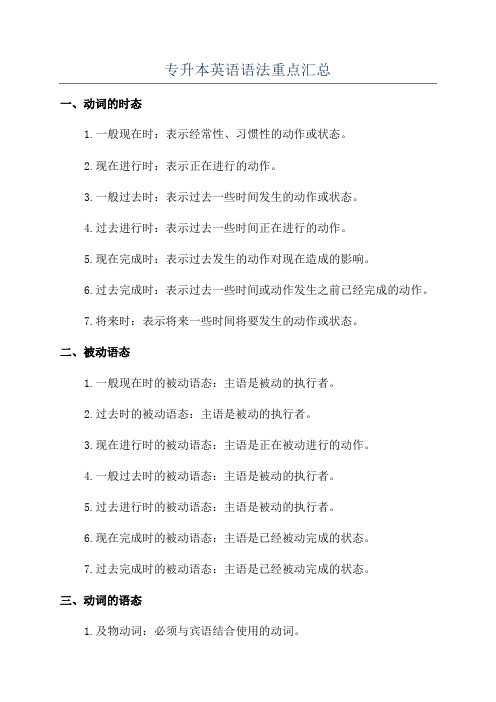
专升本英语语法重点汇总一、动词的时态1.一般现在时:表示经常性、习惯性的动作或状态。
2.现在进行时:表示正在进行的动作。
3.一般过去时:表示过去一些时间发生的动作或状态。
4.过去进行时:表示过去一些时间正在进行的动作。
5.现在完成时:表示过去发生的动作对现在造成的影响。
6.过去完成时:表示过去一些时间或动作发生之前已经完成的动作。
7.将来时:表示将来一些时间将要发生的动作或状态。
二、被动语态1.一般现在时的被动语态:主语是被动的执行者。
2.过去时的被动语态:主语是被动的执行者。
3.现在进行时的被动语态:主语是正在被动进行的动作。
4.一般过去时的被动语态:主语是被动的执行者。
5.过去进行时的被动语态:主语是被动的执行者。
6.现在完成时的被动语态:主语是已经被动完成的状态。
7.过去完成时的被动语态:主语是已经被动完成的状态。
三、动词的语态1.及物动词:必须与宾语结合使用的动词。
2.不及物动词:不需要与宾语结合使用的动词。
四、倒装句1.完全倒装:把助动词或情态动词放在主语前。
2.部分倒装:把助动词或情态动词放在谓语动词前。
五、情态动词1. can:表示能力、许可、可能。
2. could:表示过去的能力、许可、可能。
3. may:表示允许、可能。
4. might:表示过去可能。
5. must:表示推测、必须。
6. shall:表示将来的意愿。
7. should:表示建议、应该。
8. will:表示将来。
9. would:表示过去习惯、愿意。
六、名词1.可数名词:可以用来计数的名词。
2.不可数名词:不可以用来计数的名词。
3.特殊名词变复数形式。
4.特殊名词变单数形式。
七、形容词和副词1.形容词在句中的位置。
2.形容词比较级和最高级。
3.副词在句中的位置。
4.副词比较级和最高级。
五、代词1.主格代词:作为主语的代词。
2.宾格代词:作为宾语的代词。
3.物主代词:表示所属关系的代词。
4.反身代词:表示动作反过来作用于自己的代词。
专升本英语词汇和语法考点总结
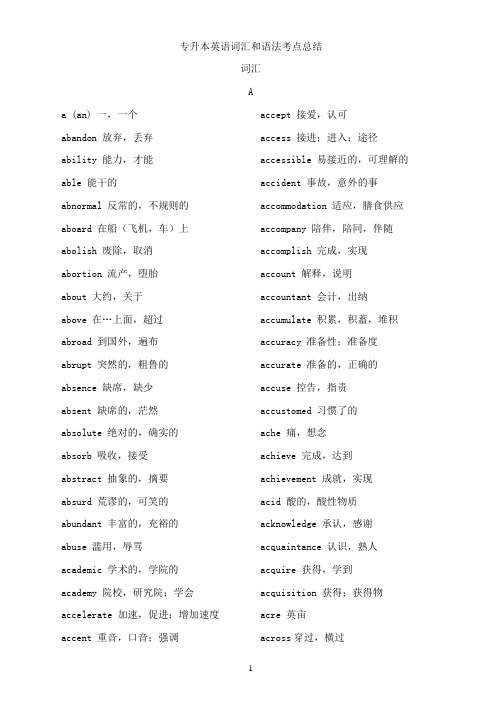
专升本英语词汇和语法考点总结词汇Aa (an) 一,一个abandon 放弃,丢弃ability 能力,才能able 能干的abnormal 反常的,不规则的aboard 在船(飞机,车)上abolish 废除,取消abortion 流产,堕胎about 大约,关于above 在…上面,超过abroad 到国外,遍布abrupt 突然的,粗鲁的absence 缺席,缺少absent 缺席的,茫然absolute 绝对的,确实的absorb 吸收,接受abstract 抽象的,摘要absurd 荒谬的,可笑的abundant 丰富的,充裕的abuse 滥用,辱骂academic 学术的,学院的academy 院校,研究院;学会accelerate 加速,促进;增加速度accent 重音,口音;强调accept 接爱,认可access 接进;进入;途径accessible 易接近的,可理解的accident 事故,意外的事accommodation 适应,膳食供应accompany 陪伴,陪同,伴随accomplish 完成,实现account 解释,说明accountant 会计,出纳accumulate 积累,积蓄,堆积accuracy 准备性;准备度accurate 准备的,正确的accuse 控告,指责accustomed 习惯了的ache 痛,想念achieve 完成,达到achievement 成就,实现acid 酸的,酸性物质acknowledge 承认,感谢acquaintance 认识,熟人acquire 获得,学到acquisition 获得;获得物acre 英亩across穿过,横过act 行动,表演active积极的,活动的activity活动,活动性actor演员,男演员actress女演员actual 实际的,现行的acute尖的,急性的AD 公元;广告ad= advertisement 广告,做广告adapt使适应,改编adaptation改编,适应add 加,进一步说(或写)addicted 沉溺的,上瘾的addition 加法,增加address地址,住址adequate充足的,任任的adjust调整,校整,适应于adjustment 调整,校整administration管理,经营,行政admirable可赞赏的,堂堂的admire羡慕,钦佩admission 允许进入,入场费admit 承认,接纳adolescence 青春期,青少年adolescent 青少年的,青春期的adopt 采取,收养ore 崇拜,热爱ad adult 成的人的,已成熟的advance促进,提高,advantage 优势,利益adventure 冒险,奇遇advertisement 广告,登广告advice 劝告,意见advise 劝告,建议,通知advocate提倡,提倡者affair事情,事务affect 影响,感动affection 爱,感情,作用afford 提供,负担的起afraid 害怕的,恐怕Africa 非洲African非洲的,非洲人的after 在……后面,后来afternoon下午,午后afterward(s) 然后,后来again再,又,此外against反对;倚靠age 年龄,时代agenda 议程,议事日程agent 代理人,代理商aggressive 侵略的,有进取心的ago 以前,……前agree 赞同,一致,约定agreement 协议,同意agricultural 农业的,农艺的agriculture 农业,农艺;农学ahead 在前,向前,提前aid 帮助,救护AIDS 爱滋病aim 企图,瞄准air 天空,大气;样子aircraft 飞机,飞艇airline 航线,航空公司airmail 航空邮件,航空邮政airplane 飞机airport 机场,航空港airspace 空气,空间,上空alarm 惊恐;警报album 粘贴薄;相册;文选alcohol 酒精alcoholic 酒精的algebra 代数学,代数alike 相似的,相象的alive 活着的,有活力的all 全部的,完全地allergic 过敏的,极讨厌的alley 小径,胡同allocate分配,把……拨给allow 允许,承认,考虑到allowance 允许,准许,almost 几乎,大概alone 单独的,唯一的along 沿着,向前alongside 在旁边,横靠aloud 出声地,大声地alphabet 字母表already 已,已经also 也,同样;而且alternative两者选一的;交替的although 尽管,虽然altitude 高度,高处altogether 完全,全部,总共aluminium 铝always 总是,一直,永远am是am. / am, AM. / AM 上午amateur 业余的,业余爱好者amazing 令人惊异的America美国,美洲ambassador (ambassadress) 大使,使节ambiguous 暧昧的,不明确的ambition 野心,抱负ambulance 救护车;野战医院among 在……中间amount 数量,总计ample 充分的,足够的amuse 逗乐,使……开心amusement 娱乐,消谴analyse 分析,分解analysis 分析,解析ancestor 祖先,祖宗ancient 古代的,古老的and 和;并且;那么anecdote 轶闻,轶事anger 愤怒,使……发怒angle 角,角度,观点angry 愤怒的;生气的animal 动物;肉欲的ankle 踝,脚脖子anniversary 周年,周年纪念日announce 宣布,发表annoy 使生气,使恼火annual 每年的,年报another 另一;别的answer 回答,答复ant 蚂蚁Antarctic 南极的;南极区antique 古代的,古物anxiety 焦虑,担心anxious 焦虑的,渴望的any 一些,任何anybody 任何人,无论谁anyhow 无论如何;总之anyone 无论谁,任何人anything 任何事,一切anyway 不管怎样说,总之anywhere 无论哪里,任何地方apart 分开,相距apartment 房间apologize 道歉;辩解apology 道歉;辩护apparent 表面的,显然的appeal 请求,呼吁,上诉appear 出现,显露appearance显露,外观appendix 附录;附属物appetite 胃口;爱好;欲望applaud 喝彩,欢呼apple 苹果,苹果树applicant 申请人application 申请,申请表,实用apply 申请,应用appoint 任命,委派,指定appointment 约会,认命appreciate 欣赏,鉴别appreciation 欣赏,鉴别approach 接近,走近,处理appropriate 适当的,拨款,占用approval 同意,赞成,批准approve 赞成,同意,批准approximately 近似的,大约apron 围裙arbitrary 任意的,武断的,专断的arch 拱形,用拱连接architect 建筑师,设计师architecture 建筑,建筑学Arctic 北极,北极的are 是area 空地,面积argue 争辩,辩论argument 争论,论点arise (arose, arisen) 出发,发生,由……引起arithmetic 算术,四则运算arm 手臂,武装armchair 扶手椅army 军队,大群around 周围,到处,大约arrange 安排,整理arrangement 排列,整理arrest 逮捕;惹人注目的arrival 到达,到达者arrive 到达,抵达;到来arrow 箭,箭头号art 艺术,美术article 文章,论文artificial 人工的,人造的artist 艺术家,美术家as 同样的;像……一样ash 灰,灰末;骨灰ashamed 羞耻;惭愧Asia 亚洲Asian 亚洲人aside 在旁边ask 询问,请求asleep 睡着的,熟睡aspect 样子,而貌assess 估定,评定assessment 估价,评价assist 援助,帮助assistance 帮助,援助assistant 助手,助教;帮助的associate 把……联系在一起;交往association 联合,交往assume 假定,承担assumption 假定,设想astonish 使惊讶的,使吃惊的astronaut 太空人,宇航员astronomer 天文学家astronomy 天文学at 在,向,对athlete 运动员,田径运动员athletic 运动的,体育的Atlantic 大西洋的,大西洋atmosphere 大气压,环境,气氛atom 原子,微量attach 固定住,附加attack 固定住,附加attain 达到,获得,完成attempt 尝试,试图attend 出席,参加,照顾attention 注意,留意,立正attitude 姿势,态度attract 吸引,引诱attraction 吸引,吸引力attractive 迷人的,引人注意的audience 听众,观众,读者aunt 姨母,姑母,伯母……authentic 真的,原作的,可靠的author 作家,作者,创造者authority 官方,当局,权力automatic 自动的机器autonomous 自主的,自治的autumn 秋,秋季available 可利用的,可得到的avenue 大街,途径average 平均,平均的avoid 避免,回避,逃避awake (awoke, awoken)award 唤醒,醒来,醒着的aware 意识到,知道的away 离开,远离awesome 可怕的awful 可怕的,讨厌的awkward 尴尬的,笨拙的Bbaby 婴儿,孩子气的bachelor 单身汉back 背部,后面的background 背景,后景,经历backward(s) 向后地,相反地bacon 咸肉bacterium 细菌bad (worse, worst) 坏的,有害的badminton 羽毛球bag 包,口袋baggage 行李bakery 面包店balance 使平衡;天平balcony 阳台,二楼包厢ball 球,舞会ballet 芭蕾舞balloon 气球,使成气球状bamboo 竹子ban 禁止,取缔banana 香蕉band 带,乐队,一伙bandage 绷带,包扎bank 银行;岸bar 条,棒;酒吧barbecue 烤肉架barber 理发师barbershop 理发店bare 赤裸的;仅仅的bargain 交议;便宜货bark 吠叫,咆哮barrier 栅栏;障碍base 基础;基地baseball 棒球,棒球运动basement 地下室,底部basic 基础的,根本的,主要的basin 盆,洗脸盆basis 基础,主要成分basket 筐,篮,篓basketball 篮球bat 球棒;击球bath 洗澡;浴室bathe 给……洗澡;弄湿bathroom 浴室,卫生间bathtub 浴缸battery 电池,一系列battle 战役,斗争bay 海湾,阻挡B. C. 一(个);每一(个)be (am, is, are, was, were, being, been)是beach 海滩,河滩bean 豆,蚕豆bean curd 豆腐bear1 熊,粗鲁的人bear2 忍受beard 胡须,络腮胡子beast 兽类;凶残的人beat (beat, beaten) 打击;心跳beautiful 美丽的,美好的beauty 美,美人because 因为become (became, become) 成为,变得bed 床;河床beddings 寝具bedroom 卧室bee 蜜蜂;忙碌的人beef 牛肉;发牢骚beer 啤酒before 以前;在……前面beg 乞讨;请求begin (began, begun) 开始behalf 利益,唯护behave 行为,举止behaviour 习行;习性behind 在…后面;落后于being 存在,生存;生物belief 相信;信仰believe 相信,认为bell 铃,钟声belly 肚子;腹部belong 属于,应归入below 在…下面;到下面belt 腰带;地带bench 长凳;(工作)台bend (bent, bent) (使)弯曲,屈服beneath 在…下面;在下方beneficial 有利的;有益的benefit 利益;津贴;有益于bent 嗜好,倾向;下决心的beside 在…旁边;在…附近besides 除…之外;而且betray 出卖,背叛;暴露between 中间;在(两者)之间beyond 在…之外;超出bicycle 自行车,脚踏车bid 报价,投标;出价big 大的,重要的;大量地bike=bicycle 自行车bill 账单;票据;钞票;法案bingo 一种赌博游戏biochemistry 生物化学biography 传记biology 生物学;生态学bird 鸟,禽类birth 出生;出身;起源birthday 生日;纪念日birthplace 诞生地biscuit 饼干;点心bishop 主教bit 一点;比特;钻头bite (bit, bitten) 咬;刺痛bitter 辛苦的,严寒的black 黑;黑暗的blackboard 黑板blame 责怪;过错blank 空白的;表格blanket 毯子;覆盖层bleed 出血,流血bless 祝福,保佑blind 瞎的;盲目的block 大块;障碍物;赌塞blood 血;血统,出身blouse 女衬衫;童衫blow (blew, blown) 吹;爆炸;吹气blue 蓝色的;忧郁的board 板;委员会boat 小船;划船body 身体;正文boil 沸腾;煮沸bomb 炸弹;轰炸bond 粘合;联合bone 骨头;骨骼bonus 奖金;补贴;红利book 书本;卷;预订boom 繁荣;(发出)隆隆声boot 靴子;解雇booth 货摊;小间border 边缘;和…接界bored 无趣的;烦人的boring 钻孔,挖动born 出生的,天生的borrow 借,借入boss 老板,上司;指挥botanical 植物的botany 植物学both 二者,双方的bother 打扰,麻烦,担心bottle 瓶子,容器bottom 底,底部,根基bounce 反跳,弹起;跳起bound 一定的,有义务的boundary 分界线,边界bow 鞠躬,点头;弓状物bowl 碗,钵;碗状物bowling 保龄球box 盒子,包厢;拳击boxing 拳击(运动)boy 男孩;侍者boycott 联合抵制,罢(课,市等)brain 大脑;心智brake 闸,刹车;减速branch 树枝,分枝;部门brand 烙印;商标;铭记brave 勇敢的,英勇的bravery 勇敢,大胆bread 面包,食物break (broke, broken) 打破,破坏breakfast 早餐;吃早饭breakthrough 突围,突破点breast 乳房,胸脯;奋勇抵抗breath 呼吸;一口气breathe 呼吸,吸入breathe 呼吸,吸入breathless 气喘吁吁的;死的brewery(啤酒)酿造厂brick 砖,方木块bride 新娘bridegroom 新郎bridge 桥,桥梁;桥牌brief 短暂的,简洁的;摘要bright 明亮的;欢快的;聪明的brilliant 明亮的;光辉的;卓越的bring (brought, brought) 带来,引起broad 宽阔的,广泛的broadcast广播,播音brochure 假订本,小册子broken 弄坏的,被打碎的broom 扫帚brother 兄弟,同胞brown 棕色的,褐色的brunch 早午餐brush 刷;刷子;画笔Buddhism 佛教budget 预算;经费buffet 自助餐build (built, built) 建筑,建设building 建筑物,大楼bunch (一)束,串bungalow 平房,小屋burden 负担,载重,义务bureaucratic 官僚的burglar 夜盗,窃贼burn (burnt, burnt或-ed, -ed) 燃烧;烧伤burst 爆炸,破裂bury 掩盖,埋藏bus 公共汽车bush 灌木business 生意;业务;企业businessman/ woman 商人busy 繁忙的;使忙于but 但是;除…之外butcher 屠夫,肉贩;屠杀butter 黄油,奶油butterfly 蝴蝶button 扣子,按纽;紧扣buy (bought, bought) 购买,交易by 被,经,由;经过bye 再见Ccab 出租马车,出租车cabbage 洋白菜,卷心菜café 小餐馆;咖啡厅cafeteria 自助餐厅cage 笼,鸟笼calculate 计划,核算,推测cake 饼,蛋糕;块call 叫做,叫喊;打电话calm 平静的,镇静的camel 骆驼camera 照相机,摄影机camp 野营,营地,扎营campaign 战役,运动can (could); can’t =cannot 能,会,可以modal 形式的;模态的can 筒,罐头canal 运河,沟渠,水道cancel 取消,作废,删除cancer 癌症,肿瘤candidate 候选人,应试者candle 蜡烛candy 糖果canteen 小卖部,临时餐室cap 帽子,帽状物capital 首都;资本;重要的capsule 胶囊,太空舱captain 船长,陆军队长;陆军上尉caption 标题,说明,解说词car 车,汽车,车厢carbon 碳card 卡片,名片,请帖care关心,愿意,照料careful 小心的,仔细的careless 粗心的,疏忽的carpenter 木工,木匠carpet 地毯,训斥carriage马车,客车厢carrier运载工具,搬运人carrot 胡萝卜carry 搬,拿,运载cartoon 卡通片,漫画carve 雕刻,切割case 情况,病例,箱cash 现金,现款;兑现cassette 珠宝箱,暗盒;字盒cast (cast, cast) 投;撒;铸件castle 城堡;置…于城堡中casual 偶然的,随便的cat 猫,猫科动物catalogue 目录;为…编目catastrophe 灾难,灾祸catch (caught, caught) 抓住,赶上category 门类,种类,范畴cater 满足,迎合,投合catholic 天主教的,天主教徒cattle 牛,牲口cause 造成,致使;原因caution谨慎,警告cautious 小心的,谨慎的cave 山洞,洞穴CD=compact disk 光碟ceiling 天花板,顶蓬celebrate 庆祝,庆贺;赞美celebration 庆祝会,典礼cell 细胞,电池,小房间cent 分,分币;百centigrade 摄氏温度的,摄氏温度centimeter 厘米central 中心的,中央的;主要的centre 中心,中枢,集中century 世纪,百年ceremony 典礼,礼节certain 肯定的,必然的certificate 证书,证件,执照chain 链,一系列chair 椅子,主席位chairman/ woman 主席,议长,会长chalk 粉笔challenge 挑战,艰巨任务challenging 挑战性的,有魅力的champion 冠军;保卫chance 机会,机遇;可能性change 改变,交换;变化changeable 易变的,可变的channel 海峡,航道;传送chant 歌,歌唱chaos 混乱,混沌character 性格;特征;符号characteristic 特性,特征;本性的charge 费用,控告;使充满chapter 章,回,篇chart 图,图表chat 聊天,闲谈cheap 廉价的,便宜的;劣质的cheat 欺骗,骗取;骗子check 检查;阻扯;支票cheek 面颊,脸蛋cheer 高兴,欢呼;振奋cheerful 高兴的,使人愉快的cheers 举标敬酒之用语cheese 乳酪,干酪chef 厨师,厨师长chemical 化学的,化学制品的chemist 化学家,药剂师chemistry 化学cheque 支票chess 国际象棋chest 胸,胸腔;柜子chew 咀嚼,思量chicken 小鸡,鸡肉;胆小的chief 主要的;首长child 小孩,儿童childhood 童年,幼年chocolate 巧克力;深褐色的choice 选择;精选的choir 歌唱队choke 窒息,噎住,堵塞choose (choose, chosen) 选择,挑选;情愿chopsticks 筷子chorus 合唱(队);齐声Christian 基督教徒;信徒Christmas圣诞节church 教堂,教会cigar 雪茄烟亲吻cigarette 香烟,纸烟cinema 电影,影片circle 圆;圈子;围绕circuit 线路;一圈circulate (使)循环;(使)传播circumstance 环境,情况,条件circus 杂技场,马戏团citizen 公民,市民,居民city 城市,都市civil 公民的,国内的civilian 平民;平民的,民众的civilization 文明,文化,文明社会clap 拍手喝彩,鼓掌clarify 讲清楚,阐明class 班级;等级;课classic 传统的;最优秀的;杰作classify 把…分类;把…类为classmate 同班同学classroom 教室,课堂claw 用爪抓;爪clay 粘土,泥土clean 干净的;完全地;打扫cleaner 清尘器;清洁工clear 清晰的,晴朗的clerk 办事员,公务员clever 聪明的,灵巧的click 发出咔嗒声;情投意合climate 气候,风气climb 爬,上升clinic 医务室,门诊室clock 时钟,仪表clone 无性系close 关闭,结束cloth 布,织物;抹布clothes 衣服,服装,被褥clothing 衣服,衣着cloud 云;一缕;阴影cloudy 多云的;模糊不清的club 俱乐部;棍棒clumsy 笨拙的,愚笨的coach 旅客车厢;教练;辅导coal 煤,煤块coast 海岸,海滨;滑行coat 外套;表皮;涂上cocoa 可可粉,可可茶,可可树coffee 咖啡;咖啡色coin 硬币,钱币;铸造coincidence 巧合,同时发生coke 可乐,焦炭cold 冷的,冷淡的;伤风collar 衣领,项圈;扭住colleague 同事,同僚collect 收集,聚集collection 收集,采集;收藏品college 学院,大学collision 碰撞,冲突colour 颜色;给…着色comb 梳子,梳理combine (使)结合;(使)合并come (came, come) 来;出现;成为comedy 喜剧;喜剧性事件comfort 使舒服的;安慰comfortable 舒适的,自在的command 命令,控制,掌握comment 评论,评注;注释commercial 商业的,可获利的commit 犯(错误,罪行);提交commitment 承诺committee 委员会,全体委员common 普通的,寻常的,共有的communicate 交际;传达;通讯communication 通讯;交流;传达communism 共产主义communist 共产主义者;共产主义的companion 同伴,伴侣;陪伴company 公司;陪伴;(一)伙compare 比较;比作;对照compass 指南针;圆规compensate 补偿,赔偿;酬报compete 比赛,竞争;对抗competence 能力,胜任competition 竞赛,竞争,比赛complete 完成;完全地complex 错综复杂的;综合企业component 成分,部件;组成的composition 构成;作文;写作comprehension 理解,理解力;领悟compromise 让步;威害;妥协compulsory 强制的,必修的;规定的computer 计算机;电脑concentrate 浓缩,精选;集中concept 概念,观念concern 关系,关心;与…有关concert 音乐会,演奏会;一齐conclude 推断出,结束;缔结conclusion结论,推论;结尾concerte 商议好的,协定的condition 状况,环境,条件condemn 谴责,宣判conduct 处理,指挥;举止conductor 售票员,列车员,导体confident 确信的,自信的confidential 秘密的,表信任的conference 会议,讨论会confirm 证实,批准,确认conflict 争论,冲突,斗争confuse 使混乱;混同congratulate 祝贺,向…道喜congratulation 祝贺,祝贺词connect 连接,与…联系connection 连接,联系conscience 良心,道德心consensus 一致,共识consequence 结果,后果;重要性conservation 保存,保护;守恒conservative 小心谨慎的;保守的人consider 考虑,体谅considerate 体谅的,考虑周到的consideration 考虑,体谅,关心consist 存在于,由……组成consistent 一致的;坚持的constant 忠实的;常数constitution章程,宪法;体质construct 构筑,建造;建筑物construction 建设;建筑物consult 请教;查阅;交换意见consultant 顾问,会诊医生consume 消费,毁灭contain 包含,含有,克制container 容器,集装箱contemporary 当代的,同龄的content1 容量,内容,满足content2 满意的,高兴的continent 大陆;陆地;克制的continue 连续,继续,延伸contradict 反驳,否认;与……矛盾contradictory 反驳的;正反对contrary 相反的;矛盾contribute 投稿;捐赠contribution 损献,贡献control 控制,支配,克制controversial 引起争论的,有争议的convenience 便利,方便convenient 便利的,方便的conventional 普通的,常见的conversation 会话,谈话convey 传达,表达convince 使确信,使信服cook 炊事员,厨师cooker 炊具,锅cookie 小甜饼cool 凉爽的;沉着的;冷却copy 抄写;模仿corn 谷物,玉米corner 角,转弯corporation 公司,企业,社团correct 正确的,合适的;改正correction 订正,改正correspond 相当;与…一致corrupt 贿赂,收买cost 成本,费用;花费cosy 舒适的,暖和舒服的cottage 农舍,小屋cotton 棉花的,棉制的cough 咳,咳嗽could modal 能够count 计数,总数counter 计数器,反对;反面country 国家的,农村的countryside 乡下,农村couple 一对,两三个,连接courage 勇气,胆量,胆识course 课程;过程court 法院,球场;向…求爱courtyard 庭院cousin 堂(表)兄弟、姐妹cover 覆盖;涉及cow 母牛,奶牛;威吓crash 碰撞,坠落;应急的crayon 彩色笔(或粉笔)crazy 发疯的;狂热的cream 奶油;乳脂食品create 创造,创作,引起creature 生物,动物;人credit 信用贷款;信誉crew 全体船员crime 罪;犯罪criminal 犯罪的;罪犯criterion 标准,准则;尺度crop 收割;庄稼;收成cross 穿越;相交;交叉crossing 横度,横穿crossroads 十字路口,立交桥crowd 人群;聚满;一群cruel 残酷的,痛苦的cry 哭,叫喊cube 立方体;立方cubic 立方体的;立方的cuisine 烹调culture 文化;教养cup 杯子;奖杯cupboard 碗柜;食橱cure 治愈;消除curious好奇的,稀奇的currency 通货;流通curriculum 全部课程;必修课程curtain (窗、门)帘cushion 气垫;减轻custom 习惯,风俗;海关customer 顾客,主顾customs 关税(风俗)cut (cut, cut) 切割,削减;切口cycle 循环;(使)循环cyclist 骑自行车的人Ddad=daddy 爸爸,爹爹daily 每日的;每天;日报dam 水坝,堰堤damage毁坏,损害damp 潮湿的dance 跳舞danger 危险dangerous 危险的dare 敢;敢于dark 黑暗的,深色的darkness 黑暗,阴暗dash 冲,突进,快跑data 资料,数据database 资料库,数据库date 日期,约会daughter 女儿dawn 黎明day 日,天dead 死的,无生命的deadline 最后期限,截止日期deaf 聋的deal 量,数额dear 亲爱的;昂贵的death 死debate 辩论,争论debt 债(务)decade 十年decide 下决心,决定decision 决定,决心declare 声明,断言decline 下倾;拒绝;斜面decorate 装饰,装修decoration 装饰,装潢decrease 减少,减小deed 行为,事迹deep 深的;深地deer 鹿defeat 击败;战胜defense 防御;保护defend 保卫;防守degree 度数;学位delay 延迟,耽搁,延误delete 删除deliberately故意地delicate 纤弱的;精致的delicious 美味的;可口的delight 快乐;乐事delighted 高兴的,快乐的deliver 递送demand 要求dentist 牙医department 部,局,处和科等;系departure 离开,启程depend 依靠,依赖,指望deposit 使沉淀;存放depth 深,深度describe 描述;形容description 描述,描写desert 沙漠deserve 应受,值得design 设计,遗弃desire 要求;期望desk 书桌,写字台desperate 绝望的;拼死的dessert 正餐后的水果或甜食destination 目的地,终点destroy 破坏,毁坏detective 侦探determine 决定;决心develop 开展,开发development 发展;开发devote 专心;献身devotion 献身,忠诚diagram 图解,图表dial 拨(号);打电话dialogue 对话diamond 钻石;金刚石diary 日记dictation 听写dictionary 词典,字典die 死diet 饮食differ 与…不同difference 差别,差异different 不同的,差异的difficult 艰难的,困难的difficulty 困难,费力dig (dug, dug) 挖,掘digest 消化,领会digital 数字的,数码的dignity 庄严,端庄;尊贵dilemma 窘境,困境dimension 尺寸,尺度dinner 正餐,宴会dinosaur 恐龙dioxide 二氧化物dip 浸,蘸diploma 毕业文凭,学位证书direct 直接的;指导direction 方向,方位director 指挥者;厂长;主任directory 人名地址录dirty 脏的disability 无能;伤残disabled 残疾的disadvantage 不利,不利条件;弱点disagree 不同意disagreement 意见不同,争执disappear 消失disappoint 失望disappointed 失望的disaster 灾难,祸难discount 折扣discourage 使泄气,使失去信心discover 发现discovery 发现discrimination 歧视discuss 讨论discussion 讨论,议论disease 疾病disgusting 令人作呕的,可憎恶的dish 盘,碟dish=disc 磁盘dislike 不喜欢,厌恶dismiss 解散,解雇distance 距离distant 远的,遥远的distinction 差别,区分distinguish 区别,辨别distribute 分发,分配,分布district 区,地区,区域disturb 扰乱,打扰disturbing 烦扰的dive 跳水diverse 多种多样的;不同的divide 分,分开division 除法divorce 离婚,分离dizzy 头晕目眩的do (did, done) 做doctor 医生,博士document 文件,文献dog 狗doll 玩偶,玩具娃娃dollar 元donate 损赠,赠送door 门dormitory 宿舍dot 点double 两倍,双的;两个doubt 怀疑,疑惑down 向下,沿着download 下载downstairs 在楼下;到楼下downtown 城市的商业区dozen 一打;几十个Dr=doctor 医生,大夫draft 草图,草稿drag 拖(曳)draw (drew, drawn) 画,绘制drawback 欠缺,缺点drawer 抽屉dream (dreamt, dreamt 或-ed, -ed) 做梦,向往dress 女服,服装,穿衣drill 训练,操练drink (drank, drunk) 喝,饮drive (drove, driven) 驱赶;驾驶driver 司机,驾驶员drop 滴下,落下drug 药,药物;毒品drum 鼓drunk 醉的dry 干的;变干duck 鸭due 预期的;约定的dull 阴暗的;单调乏味的dumpling 饺子during 在…期间dusk 黄昏dustbin 垃圾箱dusty 尘土多duty 职责,义务DVD = digital versatile dish 数字视盘dynamic 有生气的;动力的dynasty 王朝,朝代Eeach 各个,每个eager 渴望的,热切的eagle 鹰ear 耳朵;听力,听觉early 早的(地)earn 挣得,赚得earth 地球;土地;泥earthquake 地震east 东,东方Easter 复活节eastern 东方的;东部的easy容易的,不费力的eat (ate, eaten) 吃ecology生态学edge边缘edition版本editor编辑,编者educate教育,培养educator教育家education教育;培养effect效果;作用effort努力,艰难的尝试egg蛋;卵eggplant茄子either两者任可一个elder长者,前辈elect选举electric电的electrical电的;电器的electricity电,电流electronic电子elegant优美的,优雅的,精致的elephant象else别的,其他的e-mail电子信函embarrass使窘迫,使为难embassy大使馆emergency紧急情况或状态emperor皇帝employ雇用empty空的encourage鼓励encouragement 鼓励end结束ending结尾,结局endless无穷无尽的enemy敌人,敌军energetic精力旺盛的energy精力,能量engine发动机,引擎engineer工程师;技师enjoy喜欢;享受…的乐趣enjoyable令人愉快的;有乐趣的enlarge扩大enough足够的;充分的enquiry询问enter进入enterprise进取心,事业心entertainment娱乐enthusiastic热情的,热心的entire完全的;整个的entrance入口;入场entry进入envelope信封environment环境envy羡慕;忌妒equal平等的;等于equality平等equip装备,配备equipment装备,设备eraser橡皮擦;黑板擦error错误,过失erupt爆发escape逃跑;逃脱especially特别;尤其essay散文;随笔,文章Europe 欧洲European欧洲人;欧洲的evaluate估价,评价;求…的值even甚至;更evening傍晚,晚上event事件;大事eventually终于,最后ever曾经;无论何时every每一,每个的everybody每人;人人everyday每天的,日常的everyone每人,人人everything每件事,每样东西everywhere到处evidence形迹,迹象;根据,证据evident明显的,显然的evolution进化,演化,渐进exact确切的;准确的exam =examination检查;考试examine检查,诊察example例子;榜样excellent极好的,优秀的except除…之外exchange交换,调换;交流excite使兴奋,使激动excuse原谅;借口exercise练习;运动;习题exhibition展览exist存在existence存在;生存exit出口,通道expand膨胀,扩张;张开expect期望,预期;以为expectation期望;预期,预料expense消费,支出expensive昂贵的experience经验;验历experiment实验expert专家,能手explain解释;说明explanation解释;说明explicit明确的,详述的explode爆炸explore开采,开发;利用export探测;探索expose使暴露,使曝光express表达;表情expression表达;词句;表情extension延长,伸展;电话分机extra 外加的;额外的extraordinary离奇的;使人惊奇的extreme末端的,尽头的;极端的eye眼睛eyesight视力;视觉Fface脸;面对facial面部用的fact事实,实际factory工厂fade褪色;消退fail失败;不及格failure 失败;不及格fair白皙的;公平的faith信仰;信念fall落下;跌倒false不正确的;假的familiar熟悉的family家庭;家族;子女famous著名的fan扇子;迷;支持者fancy想像,幻想fantastic奇异的,幻想的,异想天开的fantasy想像,幻想far (farther, farthest或further, furthest)远的fare车费,船费,票价farm农场;农庄farmer农夫fast 快的(地),迅速的(地)fasten 拴住;扎牢fat 肥胖的;脂肪father 父亲faul t缺点,毛病favour 好意;帮助;恩惠favourite 最喜爱的,最喜欢的人或物fax传真fear害怕,恐惧;担忧feast节日,宴会feather羽毛federal 联邦的;中央的fee 费feed (fed, fed) 喂,饲养feel (felt, felt) 感觉;触摸feeling 感情,感觉fellow 同伴,伙伴female 女的,雌的fence 篱笆,栅栏ferry 渡船festival节日的,喜庆的fetch拿来,取来,带来fever发烧few少数的,不多的fibre纤维(质)fiction小说;虚构,编造field地,田地;牧场fierce猛烈的fight (fought, fought) 打仗;争论figure 外形,图形;形象;数字file 文件,档案,公文柜fill 装满,填充film 影片,电影;胶卷final 最后的;终极的finance 财政,金融find (found, found) 找到;发现;感到fine 好的,美好的;晴朗的finger 手指fingermail 手指甲finish 完成,结束,做完fire 火,火灾fireworks 烟火firm 公司,企业;牢固的fish 第一的;首次的;开始fisherman 捕鱼人;钓鱼健身者fist 拳头fit 适合,安装;适合的fix 修理,安装,确定flag 旗;标志flame 火焰,光辉flash 闪光,转瞬间flashlight 手电筒flat 平的;一套房间;公寓flee (fled, fled) 逃走;逃避flexible 易弯曲的,灵活的flesh 肌肉flight 航班,楼梯的一段float 漂浮;飘动flood 洪水;淹没floor地,地板;楼层flour面粉,粉flow流,流动flower花flu流行性感冒fluency流利,流畅fluent流利的,流畅的fly (flew, flown)飞,飞行;空运;苍蝇focus聚焦,集中fog雾foggy有雾的,多雾的fold折叠;合拢folk民间的follow跟随;仿效;跟得上fond喜爱的,爱好的fool食物,食品foolish傻子,蠢人foot脚,足;英尺football足球;足球运动for为;因为forbid (forbade, forbidden)禁止,不许force强迫forecast预报,预测forehead前额foreign外国的foreigner外国人foresee (foresaw, foreseen)预见,预知forest森林forever永远,永恒的forget (forgot, forgot/ forgotten)忘记;忘掉forgetful健康的,不留心的forgive (forgave, forgiven)原谅,宽恕fork叉,餐叉form形式,形状;表格format设计,安排;使格式化former以前的,在前的fortnight十四日,两星期fortunate幸运的,侥幸的fortune财产;运气forty四十forward向前,前进;将来found 成立,建立fountain喷泉fox狐狸franc法郎fragile脆的,易碎的;脆弱的fragrant香的framework框架,构架,结构free空闲的,自由的;免费的freedom自由freeway高速公路freeze (froze, frozen)结冰;凝固freezing 结冰的,极冷的frequent时常,屡次;频繁的fresh新鲜的friction摩擦(力)fridge = refrigerator冰箱friend朋友friendly友好的friendship友谊frighten惊吓,惊恐frog蛙from从;从…起;距front前面;前线;前面的frontier边镜,国境;前沿frost霜(冻)fruit 水果;果实fry 油煎;油炸fuel 燃料full 满,充满的;完全的fun 有趣的事;玩笑;娱乐function 功能,作用;职务fundamental 基本的,基础的funeral 葬礼funny 可笑的;有趣的fur 软毛;皮毛;皮子furnished 已装修家具的furniture 家具future 将来Ggain 赚,赢得gallery 美术馆,画廊gallon 加仑game游戏,运动,比赛garage 汽车间garbage 垃圾garden 花园,果园,菜园garlic 大蒜garment (一件)衣服gas 煤气gate 大门gather 聚集gay 愉快的;(男)同性恋的general 总的;大体的;概括的generation 代;一代generous 慷慨的;宽宏大量的gentle 柔和的,轻轻的gentleman 绅士,先生geography 地理学geometry 几何学gesture 姿势,手势;姿态get (got, got)gift 赠品;礼物gifted 有天赋的,有才华的giraffe 长颈鹿girl 女孩give (gave, given) 给,付出;给予glad 高光的,乐意的glance 匆匆一看;一瞥glare 闪耀;怒视,瞪眼glass 玻璃(杯);眼镜globe 地球,地球仪glory 光荣,荣誉;赞美glove 手套glue 胶(水)go (went, gone)goal 球门,目标goat 山羊god 神;上帝gold 黄金;金的golden 金(黄)色的golf 高尔夫球good (better, best) 好,良好goods 商品;货物goose (geese) 鹅govern 统治,管理government 政府grade 等级,学年;成绩gradual逐渐的,逐步的graduate毕业graduation毕业,毕业典礼grain谷物,谷类gram克grammar语法grand庄严的;伟大的grandchild孙(女);外孙(女)granddaughter(外)孙女grandma = grandmother(外)祖母grandpa = grandfather 祖父母,外祖父母grandparents(外)祖父母grandson孙子;外孙granny奶奶;外婆grape葡萄graph图表,曲线图grasp抓紧,抓牢grass草,草地grateful感激的,感谢的gravity重力great伟大的;重大的greedy贪婪的green绿色的;青的greengrocer蔬菜水果商greet问候;向…致敬greeting祝贺grey灰白的grill烤架grocer食品商,杂货商grocery杂货店;杂货ground地面group组;群grow (grew, grown)生长;渐渐变得growth 增长,生长guarantee保证,担保guard警戒;保护装置guess猜guest客人,宾客guidance指导,引导guide向导,导游者guilty有罪的,犯法的;做错事的guitar吉他;六弦琴gun枪;炮gym = gymnasium体育馆,健康房gymnastics体操Hhabit习惯,习性hair 头发haircut剃头half半,一半hall大厅;礼堂ham火腿hamburger汉堡包hammer 铁锤,木槌hand手;指针;传递handbag手袋,女用皮包handful一把;少数handkerchief手帕handle柄,把手handsome漂亮的handwriting书法handy手边的,方便的hang (hung, hung或-ed, ed) 吊着;绞死happen发生happiness幸福,快乐happy高兴的,幸福的harbour海港,港口hard努力地;猛烈地hardly几乎不hardship艰难,困苦hardworking 辛勤工作的harm伤害,捐害harmful有害的;致伤的harmony协调,和论;融洽harvest收成,收获hat帽子;礼帽hatch孵蛋hate憎恨;不喜欢have (have, had, had) 有he 他head头;才智;标题headache 头痛headline大字标题headmaster/ mistress中小学校校长health健康;卫生healthy健康的,健壮的hear (heard, heard)听,听见;听说hearing听力heart心;纸牌中的红桃heat热;把…加热heaven天空heavy重的heel脚后跟height高,高度helicopter直飞(飞)机hello喂helmet头盔help帮助,帮忙helpful有帮助的,有益的hen母鸡her她的;她(宾格)herb草本here 这儿,在这里hero英雄,男主角hers她的herself她自己hesitate犹豫;含糊hi嘿;喂hide藏high高的highway公路,大路hill小山;土堆;斜坡him他(宾格)himself他自己hire雇用;租用his他的history历史hit (hit, hit)打;击中;撞hobby业余爱好,嗜好hold (held, held)拿,抱;举行hole洞,坑holiday假日,假期holy神圣的home家,回家,在家homeland家乡,祖国hometown故乡homework家庭作业honest诚实的,正直的honey(蜂)蜜honour荣誉,光荣hook钩;连接hope希望hopeful有希望的hopeless没有希望的horrible令人恐怕的,可怕的host马hostess医院hot热的hotdog热狗hotel旅馆,饭店hour小时house房子;住宅。
专升本英语语法与词汇知识点总结

专升本英语语法与词汇知识点总结在专升本的英语考试中,语法和词汇是两个至关重要的部分。
掌握好这两方面的知识,对于提升英语成绩和语言运用能力有着举足轻重的作用。
下面,我将为大家详细总结专升本英语中常见的语法和词汇知识点。
一、语法知识点(一)动词时态1、一般现在时表示经常发生的动作、存在的状态或客观真理。
其构成是主语+动词原形(当主语是第三人称单数时,动词要加“s”或“es”)。
例如:“He often goes to school by bike”2、一般过去时表示过去发生的动作或存在的状态。
构成是主语+动词的过去式。
如:“I played basketball yesterday”3、现在进行时表示正在进行的动作。
其结构是“主语+ be 动词+动词的现在分词”。
比如:“They are watching TV now”4、过去进行时强调过去某个时间正在进行的动作,形式为“主语+ was/were +动词的现在分词”。
像:“I was reading a book at that time”5、现在完成时表示过去发生的动作对现在造成的影响或结果,或者从过去开始一直持续到现在的动作。
其构成是“主语+ have/has +过去分词”。
例如:“She has learned English for five years”6、过去完成时表示过去某个时间之前已经完成的动作,结构是“主语+ had +过去分词”。
比如:“By the end of last year, we had learned 2000 words”(二)语态1、主动语态主语是动作的执行者。
例如:“He opened the door”2、被动语态主语是动作的承受者,构成是“be +过去分词”。
如:“The door was opened by him”(三)非谓语动词1、动词不定式具有名词、形容词和副词的特征,可作主语、宾语、定语、状语等。
专升本《英语》词汇与语法结构
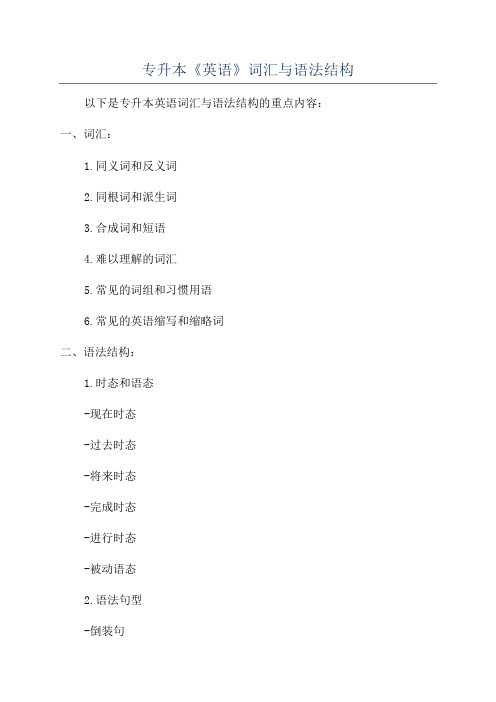
专升本《英语》词汇与语法结构以下是专升本英语词汇与语法结构的重点内容:
一、词汇:
1.同义词和反义词
2.同根词和派生词
3.合成词和短语
4.难以理解的词汇
5.常见的词组和习惯用语
6.常见的英语缩写和缩略词
二、语法结构:
1.时态和语态
-现在时态
-过去时态
-将来时态
-完成时态
-进行时态
-被动语态
2.语法句型
-倒装句
-条件句
-间接引语和直接引语
-强调句
3.从句和复合句
-名词性从句(主语从句、宾语从句、表语从句、同位语从句)-定语从句
-状语从句
-表语从句
4.代词和词性
-人称代词和物主代词
-反身代词和相互代词
-指示代词和疑问代词
-不定代词和关系代词
5.形容词和副词
-基本形容词和副词的比较级和最高级
-修饰方式、程度、时间和频率的副词
-形容词和副词的转化
6.名词和数词
-可数名词和不可数名词
-单数名词和复数名词
-名词的所有格
-基数词和序数词
以上是专升本英语词汇与语法结构的主要内容,希望对你的学习有帮助。
专升本英语语法知识点归纳

专升本英语语法知识点归纳1. 动词时态:一般现在时(Simple Present Tense)、一般过去时(Simple Past Tense)、一般将来时(Simple Future Tense)、现在进行时(Present Continuous Tense)、过去进行时(Past Continuous Tense)、现在完成时(Present Perfect Tense)、过去完成时(Past Perfect Tense)、将来完成时(Future Perfect Tense)等。
2. 名词的单复数形式:常见的复数形式有直接加s或es,不规则变化的单复数形式需要记忆。
3. 代词:人称代词(Subject/Object Pronouns)、反身代词(Reflexive Pronouns)、指示代词(Demonstrative Pronouns)、相对代词(Relative Pronouns)等。
4. 形容词和副词:形容词修饰名词,副词修饰动词、形容词或副词,形容词和副词的比较级和最高级形式。
5. 介词:表示方位、时间、原因、目的等关系,在句子中修饰名词或代词。
6. 连词:并列连词(and、or、but)、从属连词(because、if、when)、关联连词(however、therefore、besides)等,连接并列句、主从复合句。
7. 冠词:定冠词(the)、不定冠词(a,an)、零冠词,在句子中修饰名词。
8. 疑问词:用来引导疑问句的词,如who、what、where、when、why、how等。
9. 句子的基本成分:主语(Subject)、谓语(Predicate)、宾语(Object)、定语(Adjective)、状语(Adverbial)等,在句子中扮演不同的语法角色。
10. 句子的类型:陈述句(Declarative Sentence)、疑问句(Interrogative Sentence)、祈使句(Imperative Sentence)、感叹句(Exclamatory Sentence)等。
英语专升本语法知识点汇总

英语专升本语法知识点汇总一、时态。
1. 一般现在时。
- 用法:- 表示经常或习惯性的动作或存在的状态。
例如:I go to school by bike every day.(我每天骑自行车去上学。
)- 表示客观事实或普遍真理。
例如:The earth moves around the sun.(地球绕着太阳转。
)- 结构:- 主语为第三人称单数(he/she/it等)时,动词要加 -s或 -es,如He likes reading. 其他人称用动词原形,如I like reading.2. 一般过去时。
- 用法:- 表示过去某个时间发生的动作或存在的状态。
例如:I visited my grandparents last weekend.(我上周末去看望了我的祖父母。
)- 结构:- 动词一般用过去式形式。
规则动词的过去式一般在词尾加 -ed,如work - worked;不规则动词有其特殊的过去式形式,如go - went。
3. 一般将来时。
- 用法:- 表示将来某个时间要发生的动作或存在的状态。
例如:I will go to Beijing next month.(我下个月将去北京。
)- 结构:- 常见的结构有will+动词原形,be going to+动词原形(表示计划、打算做某事或有迹象表明即将发生某事)。
如He is going to have a party tonight.(他今晚打算举办一个聚会。
)4. 现在进行时。
- 用法:- 表示现在正在进行的动作或存在的状态。
例如:She is reading a book now.(她现在正在读一本书。
)- 结构:- be动词(am/is/are)+动词的 -ing形式。
5. 过去进行时。
- 用法:- 表示过去某个时刻或某段时间正在进行的动作。
例如:I was watching TV at 8 o'clock last night.(昨晚8点我正在看电视。
专升本英语语法与词汇

专升本英语语法与词汇.第一章时态英语中谓语动词的时态(Tense)是一种动词的形式,不同的时态用以表示在不同的时间完成的动作或保持的状态。
英语动词共有十六种时态,这里将重点讲解其中较常用的十种时态。
一、一般现在时( The Present Indefinite Tense)1. 用于表示客观事实, 现在反复发生或习惯性的动作以及存在的特征、状态等,常与often, always, sometimes, usually, once a week, every day, seldom等时间状语连用。
【例句】The earth revolves around the sun.The students get up at six thirty every morning.2.表示按计划或安排好的将来的动作,常使用arrive, be, go, start, stay等动词。
【例句】There is a dancing party tonight.The plane arrives in Beijing at three this afternoon.3.用在以as soon as, when, after, while, as, until, till, whenever, the monment,theminute, immediately, directly等引导的时间状语从句中或以if, unless, as/so long as, in case, provided that等引导的条件状语从句中,代替一般将来时。
【例句】I’ll ring you as soon as he comes back.If it is fine tomorrow we will go swimming.The machine starts running the moment the button is pressed.●注:if条件句中,有will出现时,will是情态动词,意义为“愿意”,“肯”。
专升本英语语法重点汇总

专升本英语语法重点汇总1.主谓一致- 单数主语与单数谓语动词搭配,如"The cat is sleeping."- 复数主语与复数谓语动词搭配,如"The cats are sleeping."- 不定代词"everyone, everybody, someone, somebody"的主语与谓语动词搭配时,使用第三人称单数形式,如"Everybody loves ice cream."2.时态- 现在进行时:表示目前正在发生的动作或临时的动作,一般由“be + 现在分词”构成,如"She is reading a book."- 现在完成时:表示过去发生的一种持续的动作或状态,与现在的影响或结果有关,一般由“have/has + 过去分词”构成,如"They have finished their homework."- 过去进行时:表示过去其中一具体时间正在进行的动作,一般由“was/were + 现在分词”构成,如"We were playing basketball yesterday."- 过去完成时:表示在过去其中一时间或动作之前已经完成的动作,一般由“had + 过去分词”构成,如"She had already eaten when I arrived."3.强调句- 强调句是为了将强调句子中的一些成分突出表达,一般由“Itis/was + 被强调部分 + that/who + 原句其余部分”构成,如"It was John who told me the good news."- 当强调句的被强调部分是动词时,需使用“do/does/did”来构成强调句,如"It was he who did all the work."4.虚拟语气- 与现在事实相反的虚拟语气,使用"would, could, might"等情态动词与原型动词搭配,如"If I were you, I would go to the party."- 与过去事实相反的虚拟语气,使用"had + 过去分词"构成,如"IfI had known, I would have helped him."5.定语从句- 定语从句用来修饰先行词,修饰的内容可以是人、事物或整个句子,一般由关系代词"who, whom, whose, which, that"或关系副词"where, when, why"引导,如"The book that I bought is very interesting."6.名词性从句- 主语从句:作为句子的主语,一般由"that, whether, who, whom, which"引导- 宾语从句:作为句子的宾语,一般由"that, whether, if, what, who, whom, which"引导,如"I don't know what to do."- 表语从句:位于系动词之后,与主语构成等价关系,一般由"that, whether, who, whom, which"引导,如"The important thing is that you try your best."7.比较级和最高级- 比较级用来比较两个人或物之间的差异,一般在形容词或副词前加"more"或"less"构成,如"She is taller than her sister."- 最高级用来表示三个或三个以上人或物之间的差异,一般在形容词或副词前加"the most"或"the least"构成,如"He is the tallest boy in the class."以上是专升本英语语法的重点汇总,希望对你的学习有所帮助。
专升本《英语》词汇与语法结构
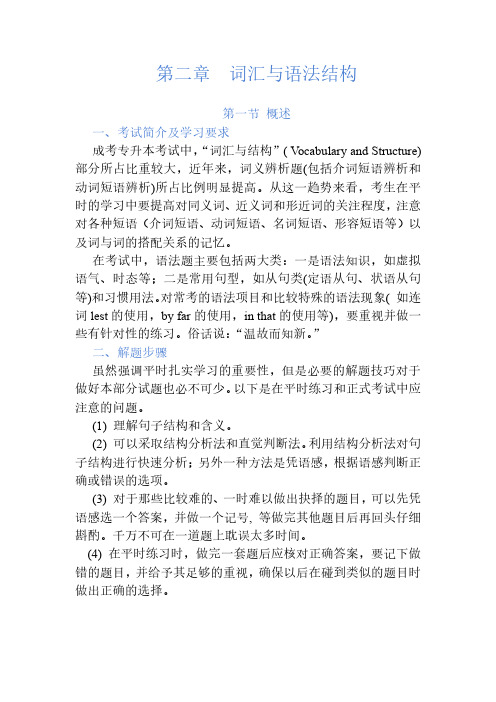
三、语法结构问题
语法结构主要是时态、语态、虚拟语气、非谓语动词、从句(包
future 前途,例如 a job with plenty of future 有很大发展前途的工
作,常与介词 with 搭配,且不用 considerable 来修饰; C. possibility
可能性与 D. opportunity 机遇通常不用来修饰人。
3.短语辨析
例1
In my opinion, he's
其他三项均不合乎语法要求,不予选择。
例2
To our ,Geoffrey's illness proved not to be as serious as we
had feared.
A. anxiety
B. relief C. view D. judgment
【句意】令我们感到欣慰的是,杰弗里的病不像我们担心的 那样严重。
通过英文释义去把握单词的确切内涵。
例2
The neighborhood boys like to play basketball on the lot.
A. valid
B. vain
C. vacantFra bibliotekD. vague
【句意】附近的男孩子们喜欢在那块空地上打篮球。
【精析】C 本题是一道词义辨析题。所给的四个单词从形式
【句意】 这本书旨在促进科研 与教学,尤其是研究人 员与
专升本英语语法与词汇知识点总结

专升本英语语法与词汇知识点总结英语在专升本考试中占据着重要的地位,而语法和词汇则是英语学习的基石。
掌握好语法和词汇,对于提升英语成绩,顺利通过专升本考试至关重要。
以下是为大家总结的专升本英语语法与词汇的重要知识点。
一、语法知识点1、时态时态是英语语法中的重点,包括一般现在时、一般过去时、一般将来时、现在进行时、过去进行时、现在完成时、过去完成时、过去将来时等。
一般现在时表示经常发生的动作或存在的状态,如:I go to school every day(我每天上学。
)一般过去时表示过去发生的动作或存在的状态,如:He played football yesterday(他昨天踢足球了。
)一般将来时表示将来要发生的动作或存在的状态,如:I will go to Beijing next week(我下周要去北京。
)现在进行时表示正在进行的动作,如:They are watching TV now (他们现在正在看电视。
)过去进行时表示过去某个时刻正在进行的动作,如:I was reading a book at eight last night(昨晚八点我正在读书。
)现在完成时表示过去发生的动作对现在造成的影响或结果,如:I have finished my homework(我已经完成了作业。
)过去完成时表示过去某个时间之前已经完成的动作,如:By the end of last year, I had learned 3000 words(到去年年底,我已经学了 3000 个单词。
)2、语态语态分为主动语态和被动语态。
主动语态表示主语是动作的执行者,被动语态表示主语是动作的承受者。
被动语态的构成是“be +过去分词”,如:The book is written by him (这本书是他写的。
)3、非谓语动词非谓语动词包括动词不定式、动名词和分词(现在分词和过去分词)。
动词不定式可以作主语、宾语、定语、状语等,如:To learn English well is not easy(学好英语不容易。
专升本考试英语语法总结

专升本考试英语语法总结充当宾语形式:1)名词2)代词3)名词短语4)名词从句5)数词6)不定式7)-ing形式形式宾语(名词从句,不定式,动名词)(见第六讲主语和宾语)4.表语:说明主语的身份和情况。
(跟在系动词后)Time is money.Three o’clock is always too late or too early for anything you want to do.你想做什么事,三点钟总是太早或太迟。
构成形式:1)名词2)形容词3)代词4)数词5)不定式6)ing形式7)过去分词8)副词9)介词短语10)小品词11)名词从句5.补语:补充说明。
(由动词类别来决定)构成形式:1)名词2)代词3)形容词4)数词5)不定式6)-ing形式7)过去分词8)介词短语9)副词小品词10)名词从句主语补语Tom was made monitor.宾语补语I made Tom monitor.表语补语I am sure to succeed.6. 定语:对名词性形式进行范围限定。
This is beautiful music.There are only two kinds of music…good and bad.自古音乐分两种,好的和坏的。
构成形式:1)限定词2)形容词3)名词4)数词5)不定式6)-ing形式7)过去分词8)介词短语9)副词10)关系从句7. 同位语:对被修饰对象进行补充说明或进一步解释。
Puff, the magic dragon, lived by the sea.构成形式:1)名词2)代词3)名词短语4)数词5)不定式6)-ing形式7)名词从句8. 状语:修饰词,短语,从句和整句。
位置:自由自在。
1)修饰性状语:修饰动词,形容词,副词等(时间,地点,肯定,否定,程度,频度,方式,伴随,原因,目的,比较等)。
Can you feel the love tonight?Home never looks so good as when you come back from getting away from it.只有出走又回家时,家才最感亲切。
2021最新整理成考专升本《英语》基础知识、语法考点汇总
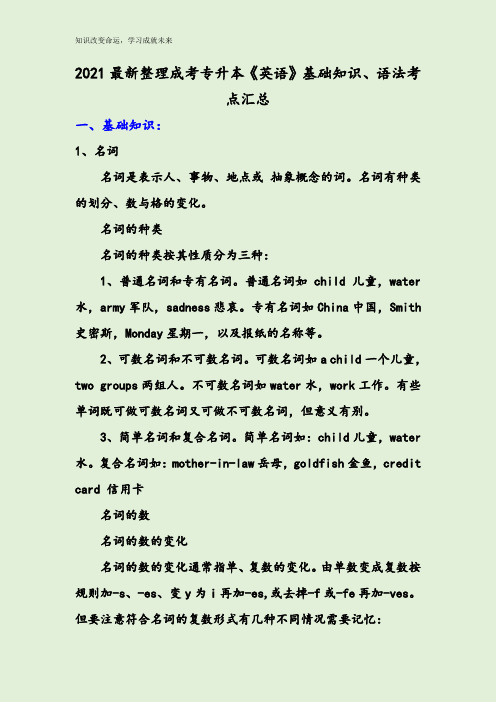
2021最新整理成考专升本《英语》基础知识、语法考点汇总一、基础知识:1、名词名词是表示人、事物、地点或抽象概念的词。
名词有种类的划分、数与格的变化。
名词的种类名词的种类按其性质分为三种:1、普通名词和专有名词。
普通名词如child儿童,water 水,army军队,sadness悲哀。
专有名词如China中国,Smith 史密斯,Monday星期一,以及报纸的名称等。
2、可数名词和不可数名词。
可数名词如a child一个儿童,two groups两组人。
不可数名词如water水,work工作。
有些单词既可做可数名词又可做不可数名词,但意义有别。
3、简单名词和复合名词。
简单名词如:child儿童,water 水。
复合名词如:mother-in-law岳母,goldfish金鱼,credit card 信用卡名词的数名词的数的变化名词的数的变化通常指单、复数的变化。
由单数变成复数按规则加-s、-es、变y为i再加-es,或去掉-f或-fe再加-ves。
但要注意符合名词的复数形式有几种不同情况需要记忆:(1)最后的部分变为复数形式:如traffic light——traffic lights红绿灯。
(2)主要部分变为复数形式:如mother-in-law——mothers-in-law岳母、婆婆。
(3)以man或woman为第一部分的复合名词变复数时,前后都变复数:如man worker——men workers。
冠词冠词分为三类:定冠词(the)、不定冠词(a/an)和零冠词(无冠词)。
冠词虽本身无意义,但在英语语言中又是不可缺少的一部分。
冠词的位置和用法的一些细节是不可忽视的。
冠词的位置1、定冠词通常位于所修饰的名词或名词的修饰语之前。
例如:the student 学生the fresh air 新鲜的空气定冠词置于某些词之后。
这些词是:all,both,half,three times,twice等。
2021年专升本考试英语真题及答案解析2
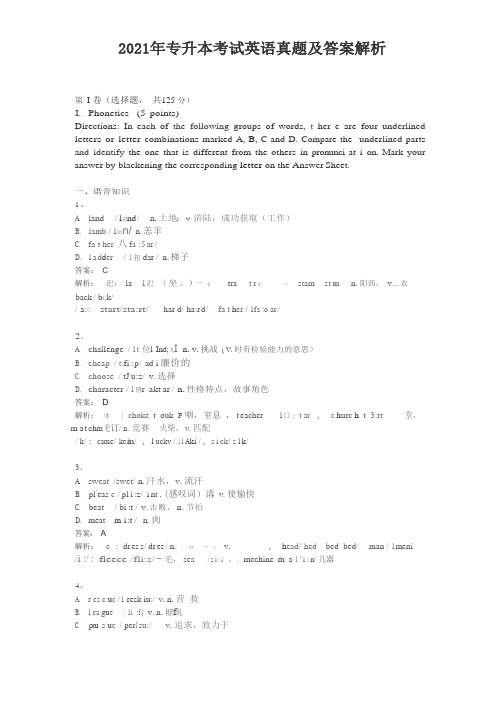
2021年专升本考试英语真题及答案解析第I 卷(选择题,共125 分)I.Phonetics (5 points)Directions: In each of the following groups of words, t her e are four underlined letters or letter combinations marked A, B, C and D. Compare the underlined parts and identify the one that is different from the others in pronunci at i on. Mark your answer by blackening the corresponding letter on the Answer Sheet.一、语音知识1、nd / 1汜nd /n. 土地;V. 浒陆,成功获取(工作)mb / 1劭n/ n. 恙羊C.fa t her 八fa :5 ar /D.l a d d er / 1 扭dar / n. 梯子答案:Cn.阳西,v... 农解析:汜:la 1汜(坐、)-甘tra t r 祀•stam st m祀back / b汜k// a:/: start/sta:rt/ har d/ ha:r d/ fa t h er / 1fa :o ar /2、A.challenge / 1t 位l Ind;飞I n. v. 挑战( V. 时有检验能力的意思)B.cheap / t.fi :p/ ad-i 廉价的C.choose / tJ u:z/ v. 选择D.character / 1 胜r akt ar / n. 性格特点,故事角色答案:D解析:/t : choke t ouk P 咽,窒息,t eacher 1 口:t ar , c h urc h t 3:rt堂,m a t ch m/祀订/n.竞赛火柴,v.匹配/k/:came/ke m1/,l uckv/11A ki/,s i ck/s1k/3、A.sweat /swet/ n. 汗水,v. 流汗B.pl eas e / pl i :z/ i nt . (感叹词)请,V. 使愉快C.beat / bi :t / v. 击败,n. 节拍D.meatm/i:t/n. 肉答案:A解析: e : dr es s /dr es / n.: 壮- ·, v. - , h ead/ hed bed bed/ man / 1meni /i :/ : fleece /fli:s/ -毛,sea / s i :、/ 、,mechine m/ a 1 ' i : n/ 几器4、A.r es c u e /1 resk iu:/ v. n. 营救B.l ea g u e/li:f'.)/v. n. 耜夭f乱C.p r u s u e / per I su:/ v. 追求,致力于D.ar g u e/1o:r f:ii u:/v.争论,表明答案:B5、A. a c t i o n / 1汜kJ n/ n. 行动B. s ect i o n/ 1 s e kJ n/ n. 部分,部门C.sol u t i o n/ s a1 l u「: n/ n. 解决方案D.q u es 口o n/ 1 k wes t「a n/ n. 问题,V. 提问,质疑答案:D解析:/ J n/ 和/ t J a n/ 其实看的是/ J / 和/ t J //s o un d s l i k e ou want so m eo n e to be u i e t:shi1/s u r e/or/n a t i o n 1 ne 1J n/ , f i s h/ f 1.f /t : c h oke t oo k U , 照,t eac h er / 1 ti:t er , c hu r c h t 3:rt 学,m a t c hm/汜t J/n.竞邪,火柴,v.匹配二、词汇与语法知识II.Vocabulary and Structure (15 points)Dir ect i o ns : There are15i ncom pl e t e sentences in this section.For each sentence there are four choices marked A , B , C and D. Choose one answer that best completes the sentence and blacken the corresponding l e t t er on the Answer Sheet .6、T h er e n o o n e to h e l p m e at this m m o e n t ,I n ee d t o h a nd l e t h ew or k all b y m yse lf .A.b eB. b e i n gC.to b eD.b ee n答案:B解析:语法基本规则"'"无法连接两个简单句。
专升本英语语法重点汇总

专升本英语语法重点汇总专升本英语语法重点汇总一. 词类1、名词A. 不定冠词 a(an)与定冠词 the 的用法a. 不定冠词表示某一类人或某事物中的任何一个,经常用在第一次提到某人或某物时,用不定冠词起介绍作用,表示一个。
an用在元音字母前。
a与an的用法见下面例句。
B. 定冠词用法a. 定冠词特指某(些)人或某(些)事物,以区别于同类中其他的人或事物。
b. 用在由普通名词构成的专有名词前,如:the Great Wall,the People’s Republic of China.c. 定冠词用在双方都知道的人或事物之前。
d. 用在世界上独一无二的事物之前。
e. 序数词、最高级前要用定冠词。
f. 夜间、歌剧、报告等词前用定冠词。
g. 定冠词用于表示姓氏的复数名词之前。
C. 不用冠词的情况a. 季节、月份、星期、节日前不用冠词。
b. 三餐、球类运动和娱乐运动前不加冠词。
c. 普通名词前冠词的用法:a. 普通名词前加定冠词转换成修饰语表示特指意义。
b. 普通名词前加不定冠词表示一种新的概念,方位名词前加不定冠词表示一种泛指意义。
2、数词A. 基数词的构成(零除外)B. 倍数词的构成C. 分数的构成:基数词作分子,序数词作分母。
D. 序数词的构成:由基数词加th构成,个位数基数词前加不定冠词a,五、十二和二十之前的基数词有特殊的序数词形式(五:fifth ,十二:twelfth ,二十:twentieth 。
)E. 一般数字前不加冠词,但表示分数,百分数,一些罕见的复合数前加定冠词。
3、动词A. 动词的基本形式包括:原形、第三人称单数现在式、过去式和过去分词。
B. 动词的第三人称单数现在式:一般情况加-s;s,x,ch,sh结尾的加-es;以y结尾的改y为i再加-es;以-o结尾的加-es为辅音字母加y的结尾的变y为i再加-es;特殊情况不规则变化。
例:li涮牙--brush teeth ;zho打电话--make a telephone call ;sh做作业--do homework ;f游泳--swim ;ch中国--China ;tooth牙齿--teeth牙齿;man男人--men男人;woman女人--women女人;go-goes-went-gone去--goes;see看见--sees看见。
专升本英语语法知识归纳(完整版)

about to do/be to do. (be 动词为 am/is/are; 这里 will do 出现的考点频率最高) 注意 2:如果从句中的时态是 did, 那么主句中是 would do/ shouldl do/ be going to do/ be
(rain)tomorrow.
注意 3:主句中暗含一般将来时,从句中仍然用一般现在时(do/does) :
1. the new secretary is supposed to report to the manager as soon as she
a. will arrive
b. arrives
c. is arriving
一 时态和语态:16 种表现形式
一、一般现在时(do/does; am/is/are) 考点如下:
1. 时间状语: 2. 表示客观事实,永恒真理和规律。 必考点 1:3.(主将从现)在时间和条件状语从句中,从句中的谓语动词用一般现在时表示 一般将来时。
考法: If you pass the spoken English test, you will get a chance to go abroad. 解析: 考试一般都会给出时间/条件连词,且从句中的时态,让考生们选择主句中的时态。
Eg: we had finished all the courses by the end of last term.
We will have finished all the courses by the end of next term.
(2)过去完成时: by the time/when +(did), 主句(had done) 将来完成时:by the time/when +(do/does),主句(will have done)
2021年山东专升本英语语法与词汇

大学英语语法与词汇第一章时态英语中谓语动词时态(Tense)是一种动词形式,不同步态用以表达在不同步间完毕动作或保持状态。
英语动词共有十六种时态,这里将重点解说其中较惯用十种时态。
现以动词do为例,将英语十六种时态列表如下:一、普通当前时( The Present Indefinite Tense)1. 用于表达客观事实,当前重复发生或习惯性动作以及存在特性、状态等,常与often,always,sometimes,usually,once a week,every day,seldom等时间状语连用。
【例句】The earth revolves around the sun.The students get up at six thirty every morning.2.表达按筹划或安排好将来动作,常使用arrive,be,go,start,stay等动词。
【例句】There is a dancing party tonight.The plane arrives in Beijing at three this afternoon.3.用在以as soon as,when,after,while,as,until,till,whenever,the monment,theminute,immediately,directly等引导时间状语从句中或以if,unless,as/so long as,in case,provided that等引导条件状语从句中,代替普通将来时。
【例句】I’ll ring you as soon as he comes back.If it is fine tomorrow we will go swimming.The machine starts running the moment the button is pressed.注:if条件句中,有will浮现时,will是情态动词,意义为“乐意”,“肯”。
2021年专升本英语必背527个核心词汇

专升本英语必背527个核心词汇1. able/ability/enable/unable/disable/disabled/disabilityable同根词用法一致,后接不定式。
比较:be able to do sth. / be capable of (doing) sth.2. 动词词缀:en-+ adj./n.或adj./n.+/-enenable/enlarge/enrich/encourage/brighten/widen/worsen/sharpen/strengthen/heighten/lengthen 3. abandon vt. 放弃,抛弃,放纵abandon oneself to 纵情于,沉溺于(=be addicted to)4. aboard adv. 在船(车)上,上船abroad adv. 在国外,到国外board n. 木板on board 在船上broad adj. 宽,宽阔5. absent adj. 不在,缺席(反:present)6. absolute adj. 完全,绝对7. absorb vt. 吸取,吸引be absorbed in 全神贯注于8. abundant adj. 丰富,大量(=plentiful)9. access n. 通路,接近,入门have access to 接近,有权使用e.g. Citizens may have free access to the public library.10. accident n. 意外事件,事故by accident 偶尔(=by chance)(on purpose 故意)11. accompany vt. 陪伴,陪伴12. accomplish vt. 完毕,达到,实现~ the taskaccomplishment n. 成就13. account n. 计算,帐目,阐明,解释on account of 由于take... into account 考虑到(= take…into consideration)account for 解释,阐明14. accuse vt. 指责,控告accuse sb. of sh. 因某事控告某人(同:charge sb. with sth. 因某事控告某人)e.g. He was accused of robbing the bank and sentenced ten years in jail.His mother charged him with being lazy.15. achieve vt. 完毕,达到achievement n. 成就,功绩16. action n. 动作,行动,举动take action to do sth. 采用行动做某事(同:take measures to do sth.)17. actor n. 男演员→actress n. 女演员类似:waitress(女侍者,女服务生),hostess(女主人),princess(公主,王妃)18. adapt vt. 使适应,改编adapt oneself to sth. 适应(= adjust oneself to sth.)e.g. He adapted/adjusted himself very quickly to the weather in the country.比较:adopt vt. 采用,收养19. advance n. 迈进,提高v. 迈进,提前in advance 预先,提前20. advantage n. 优势,有利条件(反:disadvantage n. 不利条件,缺陷)have an advantage over 赛过,占优势take advantage of 运用21. advertise v. 为…做广告advertisement/ad n. 广告22. advise vt. 劝告,忠告advise sb. to do sth. 劝告(强调动作)persuade sb. to do sth. 说服(强调成果)注意:advise宾语从句或It is advised that构造主语从句,需使用should型虚拟语调。
2021成人高考专升本英语复习资料大全
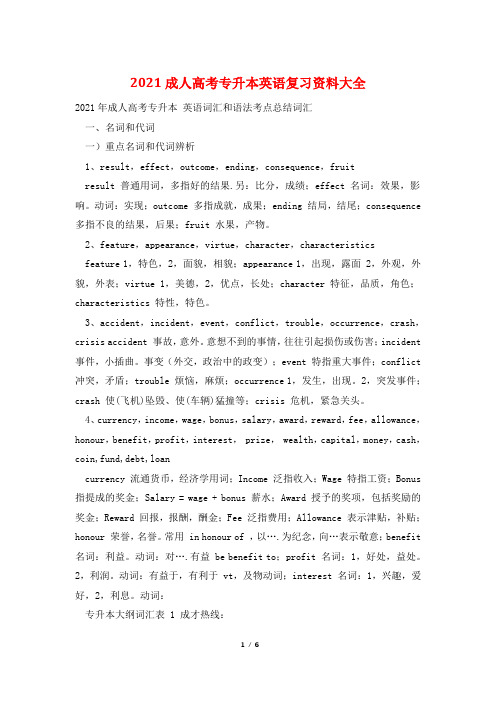
2021成人高考专升本英语复习资料大全2021年成人高考专升本英语词汇和语法考点总结词汇一、名词和代词一)重点名词和代词辨析1、result,effect,outcome,ending,consequence,fruitresult 普通用词,多指好的结果.另:比分,成绩;effect 名词:效果,影响。
动词:实现;outcome 多指成就,成果;ending 结局,结尾;consequence 多指不良的结果,后果;fruit 水果,产物。
2、feature,appearance,virtue,character,characteristicsfeature 1,特色,2,面貌,相貌;appearance 1,出现,露面 2,外观,外貌,外表;virtue 1,美德,2,优点,长处;character 特征,品质,角色;characteristics 特性,特色。
3、accident,incident,event,conflict,trouble,occurrence,crash,crisis accident 事故,意外。
意想不到的事情,往往引起损伤或伤害;incident 事件,小插曲。
事变(外交,政治中的政变);event 特指重大事件;conflict 冲突,矛盾;trouble 烦恼,麻烦;occurrence 1,发生,出现。
2,突发事件;crash 使(飞机)坠毁、使(车辆)猛撞等;crisis 危机,紧急关头。
4、currency,income,wage,bonus,salary,award,reward,fee,allowance,honour,benefit,profit,interest, prize, wealth,capital,money,cash,coin,fund,debt,loancurrency 流通货币,经济学用词;Income 泛指收入;Wage 特指工资;Bonus 指提成的奖金;Salary = wage + bonus 薪水;Award 授予的奖项,包括奖励的奖金;Reward 回报,报酬,酬金;Fee 泛指费用;Allowance 表示津贴,补贴;honour 荣誉,名誉。
- 1、下载文档前请自行甄别文档内容的完整性,平台不提供额外的编辑、内容补充、找答案等附加服务。
- 2、"仅部分预览"的文档,不可在线预览部分如存在完整性等问题,可反馈申请退款(可完整预览的文档不适用该条件!)。
- 3、如文档侵犯您的权益,请联系客服反馈,我们会尽快为您处理(人工客服工作时间:9:00-18:30)。
专升本英语语法与词汇.第一章时态英语中谓语动词时态(Tense)是一种动词形式,不同步态用以表达在不同步间完毕动作或保持状态。
英语动词共有十六种时态,这里将重点解说其中较惯用十种时态。
现以动词do为例,将英语十六种时态列表如下:一、普通当前时( The Present Indefinite Tense)1. 用于表达客观事实,当前重复发生或习惯性动作以及存在特性、状态等,常与often,always,sometimes,usually,once a week,every day,seldom等时间状语连用。
【例句】The earth revolves around the sun.The students get up at six thirty every morning.2.表达按筹划或安排好将来动作,常使用arrive,be,go,start,stay等动词。
【例句】There is a dancing party tonight.The plane arrives in Beijing at three this afternoon.3.用在以as soon as,when,after,while,as,until,till,whenever,the monment,the minute,immediately,directly等引导时间状语从句中或以if,unless,as/so long as,in case,provided that等引导条件状语从句中,代替普通将来时。
【例句】I’ll ring you as soon as he comes back.If it is fine tomorrow we will go swimming.The machine starts running the moment the button is pressed.注:if条件句中,有will浮现时,will是情态动词,意义为“乐意”,“肯”。
二、普通过去时( The Past Indefinite Tense)普通过去时用于表达过去某时刻或某一时期内动作或状态,也可表达过去习惯性动作。
常与表白过去时间状语连用,如yesterday,then,just now,last month,two days ago,in 1990,或由when或while等引导表白过去时间状语从句。
【例句】We met him last week.Where did you live when you were young?He used to do fourteen hours a day.●提示:普通过去时不强调动作对当前影响,只阐明过去。
三、普通将来时(The Future Indefinite Tense)普通将来时用来表达将来某个时间会发生动作或状况,也可表达将来重复发生动作或习惯性动作。
【例句】We shall (will) go to Nanjing tomorrow morning.He will take part in an important race across the Atlantic.The students will have five English classes per week this term.●提示:表达将来时态其她形式与用法:1.“be going to +动词原形”表达(能看出迹象)不久就要发生事情或打算要做事。
It is going to rain.2.“be to +动词原形”表达安排好动作或安排别人去做事。
They are to meet in front of the hall.You are not to bring any materials to the exam room.3.“be about to +动词原形”表达即将发生或正要做事。
The conference is about to begin.4.“be +当前分词”有时可表达按筹划即将发生一种动作,但仅合用于少数某些动词(如arrive,come,go,leave,start等)并且常跟表达较近将来时间状语连用。
My friend is arriving here the day after tomorrow.●提示:在美国英语中第一、二、三人称都用“will+动词原形”四、当前进行时(The Present Continuous Tense)当前进行时表达此刻或现阶段正在进行动作。
但表达后一种状况时,动作此刻不一定正在进行。
【例句】We are making an experiment now.Steve is studying Chinese in Beijing.此外,当前进行时也可用来给习惯动作加上赞赏或讨厌等感情色彩。
【例句】He is always cooking some delicious food for her family.He is always finding fault with his employees.提示:并非所有动词均有进行时,有些表达状态和感觉动词普通无进行时,除非此类动词词义发生变化。
此类动词有:be,love,like,hate,believe,think(以为),feel,seem等。
【例句】Do you see anyone over there?Are you seeing someone off?(see… off 意为“为…送行”)五、过去进行时(The Past Continuous Tense)过去进行时表达过去某一时刻正在发生动作,或过去某阶段内正在发生或重复发生动作。
普通带有一种表达过去时间状语或状语从句或能通过上下文判断过去时间。
【例句】We were having a preparatory meeting at two-thirty yesterday afternoon.She was writing a composition when you came in.Bill was coughing all night long.六、将来进行时(The Future Continuous Tense)将来进行时表达将来某时也许正在发生或持续动作。
【例句】I’ll be reading this time tomorrow.Most of the young people in the town will be meeting them at the station.七、当前完毕时(The Present Perfect Tense)当前完毕时表达当前已完毕或刚刚完毕动作,也可以表达从过去某一时刻发生,当前仍延续着动作或状况。
经常与for+一段时间或与since(+时间一点)引导短语或从句连用,也可与某些表达不拟定过去时间副词连用,如already,before,ever,never,just,once,recently,yet,up to now,so far,thus far,up till/to now,in the last/past few years等。
【例句】We have been to Shanghai once.They have already finished the task.He has studied English for more than 10 years.He has studied English since 1991/ since he was twelve.So far everything has been successful.八、过去完毕时(The Past Perfect Tense)过去完毕时表达过去某一时刻或动作之前已经完毕动作。
在时间上,它属于“过去过去”。
在句中常有明显参照动作或有表达“到过去某时为止”时间状语,如by,before等介词或连词引导短语或状语从句。
【例句】By the end of the war,the small workshop had become a large factory.The plane had taken off before we got to the airport.They found that a stream had formed in the field.●提示:在由after,as soon as,before等连词引导状语从句复合句中,由于连词自身已明确动作发生顺序,因此,这个从句也可以用普通过去时表达,不一定用过去完毕时。
【例句】Students went out after the bell rang.I informed him of the progress of the work as soon as I arrived here.●提示:在It is/ was the fir st/second/last time that …句型中,that后从句谓语用当前/过去完毕时。
【例句】Is it the first time you’ve visited the city?That was the second time that I’d visited England that year.九、将来完毕时(The Future Perfect Tense)将来完毕时表达将来某时前将已经完毕动作,也可以用来表达推测。
【例句】By this time next year they will have built a hotel here.Hurry up!Or the train will have left before we get to the station.十、当前完毕进行时(The Present Perfect Continuous Tense)当前完毕进行时表达从过去某时开始,始终持续到当前动作。
此动作或状况也许已停止,也也许继续下去。
但强调到说话时为止始终在进行动作。
【例句】They have been working for IBM for 15 years.I have been waiting for an hour but she still hasn’t come.有些动词如play,stay,study,teach,wait等,在表达始终继续到当前动作时,可以用当前完毕进行时,或用当前完毕时。
Bill has played (has been playing) basketball since he was sixteen years old.●提示:当前完毕时和当前完毕进行时区别是:前者强调过去发生动作对当前影响。
